TENTAMEN I STATISTISK MEKANIK
TENTAMEN I STATISTISK MEKANIK
TENTAMEN I STATISTISK MEKANIK
- No tags were found...
Create successful ePaper yourself
Turn your PDF publications into a flip-book with our unique Google optimized e-Paper software.
KONDENSERADE MATERIENS TEORIKTH<strong>TENTAMEN</strong> I <strong>STATISTISK</strong> <strong>MEKANIK</strong>Statistisk mekanik 5A1350 för F3Lördag 2002-05-25, kl. 08.00-13.00Write on each page: Name, study program and year, problem numberMotivate in detail! Insufficient motivation leads to a reduction of pointsAllowed material: Teoretisk fysiks formelblad, BETAExaminator: Anders Rosengren tel 5537 8474PART A: short questions (2 points/problem).calculation is enough.A brief answer or a short1. Show that the entropy is given byS = −k B Tr ρ ln ρ,where ρ is the density operatorρ = e −βH /Z.2. The Bragg-Williams approximation for the Gibbs free energy for the Ising model isgiven byG(h, T ) = − qJN( 1 + m2 m2 − Nhm + Nk B T ln 1 + m + 1 − m ln 1 − m ).2 2 2 2Use this result to derive the mean field equation for the magnetization m.3. Use an energy-entropy argument to show that T c = 0 for the one-dimensional nearestneighbourIsing model. Then use such an argument to estimate T c for the two-dimensionalnearest-neighbour Ising model (Hint: form a domain wall which separates a domain withall spins up from a domain with all spins down).4. Write down a Landau theory for a first-order phase transition. Make a drawing of thefree energy as a function of the order parameter for different temperatures.5. Derive the correlation length exponent ν in terms of the thermal exponent y t , definedby t ′ = l yt t, where t = (T − T c )/T c .SEE NEXT PAGE!1
PART B: problems (5 points/problem). Motivate all steps in detail.6. Starting from the scaling form for the singular part of the free energyf s (t, h) ∼ l −d f s (l yt t, l y hh),where t = (T − T c )/T c is the reduced temperature, show the Rushbrook scaling relationα + 2β + γ = 2.7. Consider a system with quenched disorder, such as the presence of impurities atrandom sites in a crystal lattice. The pure system undergoes a continuous phase transitionat T c . The effect of the disorder may be viewed as changing the nearest-neighbourexchange interaction from site to site. Therefore, the system can be modelled as a nearestneighbourmodel with a fluctuating coupling constant. Derive the Harris criterion, statingthat the disorder is irrelevant at the fixed point of the pure system (no disorder) if dν > 2.8. Calculate the magnetization for the one-dimensional Ising model in a magnetic fieldin the Bethe approximation. Compare with the exact resultm =sinh βh√sinh 2 βh + e −4βJ .Definitions of the critical exponents:c(t, h = 0) = −T ∂2 f∂T 2 ∼ |t|−αm(t, h = 0) = − ∂f∂h ∼ (−t)βχ(t, h = 0) = ∂m∂h ∼ |t|−γLYCKA TILL! / GOOD LUCK!2
KONDENSERADE MATERIENS TEORIKTH<strong>TENTAMEN</strong> I <strong>STATISTISK</strong> <strong>MEKANIK</strong>Statistisk mekanik 5A1350 för F3Lördag 2002-05-25, kl. 08.00-13.00SOLUTIONS1. With ρ = e −βH /Z, Z = e −βA , Tr ρ = 1, Tr(ρH) = E and A = E − T S we have:−k B Tr(ρ ln ρ) = −k B Tr(ρ(−βH − ln Z)) == −k B Tr(ρ(−βH + βA)) = 1 T Tr(ρH) − A T Trρ = E − AT= S.2. Minimizing the free energy with respect to m, we obtain:Answer:∂G∂m = 0 ⇒ −qJm − h + 1 2 k BT ln 1 + m1 − m = 0⇒⇒⇒ln 1 + m = 2β(qJm + h) ≡ 2x1 − me 2x = 1 + m1 − mm = ex − e −x= tanh x = tanh[β(qJm + h)]e x + e−x m = tanh[β(qJm + h)].3. See Plischke-Bergersen, pages 66 and 68-69.4. The Gibbs free energy could be written asG(m, T ) = a(T ) + b(T ) m 2 + 1 4 c(T ) m4 + 1 6 d(T ) m6 + · · · ,where c(T ) = c 0 (T − T 0 ) is negative at T = T c (T c < T 0 ). d(T ) > 0 and b(T ) is adecreasing function of T , but still positive in the region of interest. At T = T c there is adiscontinuous jump in the order parameter m. See next page for a sketch.5. ξ ′ = ξ/l and t ′ = l yt t gives( )1l = ξ′ t′ −νξ = = l −yt νt⇒ ν = 1/y t .3
T>T cT=T cT
8.∑Z c = exp [βJσ 0 (σ 1 + σ 2 ) + βhσ 0 + βh ′ (σ 1 + σ 2 )] .σ 0 ,σ 1 ,σ 2 =±1Define x = e βh , y = e 2βJ and z = e 2βh′ . Then Z c can be written asZ c = xyz + 2x + xy −1 z −1 + x −1 y −1 z + 2x −1 + x −1 yz −1 . (1)Usingandwe obtain∂x∂h = βx,〈σ 0 〉 = 1 β∂ ln Z c∂h∂x −1∂h = −βx−1 ,〈σ 0 〉 = 1 Z c[xyz + 2x + xy −1 z −1 − x −1 y −1 z − 2x −1 − x −1 yz −1] . (2)Similarly, taking into account, that〈σ 1 〉 = 1 ∂ ln Z c2β ∂h ′andwe obtain∂z∂h ′ = 2βz,∂z −1∂h ′ = −2βz −1 ,〈σ 1 〉 = 1 Z c[xyz − xy −1 z −1 + x −1 y −1 z − x −1 yz −1] .Since the system is translationally invariant, we have 〈σ 0 〉 = 〈σ 1 〉. Solving this equationfor z we obtainz = 1 [y(x 2 − 1) + √ ]4x22 + y 2 − 2x 2 y 2 + x 4 y 2orz −1 = 1 [−y(x 2 − 1) + √ ]4x2x 2 + y 2 − 2x 2 y 2 + x 4 y 2 .2Substituting these expressions back into equations (1) and (2) gives〈σ 0 〉 =x 2 − 1√x4 − 2x 2 + 1 + 4x 2 y −2 =sinh(βh)√sinh(βh) + e−4βJ .That is, the Bethe approximation is exact for the one-dimensional Ising model.5



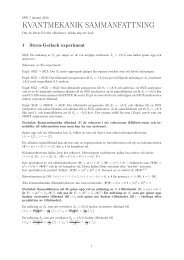

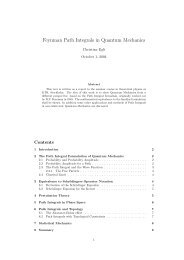
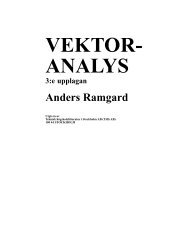
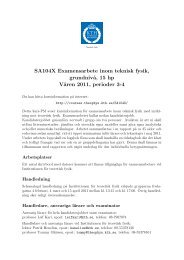

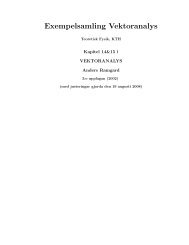

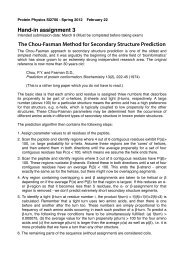

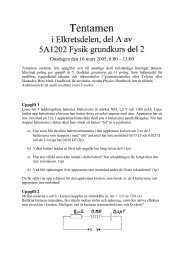
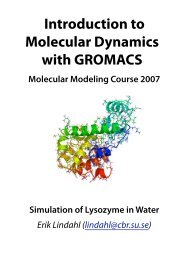
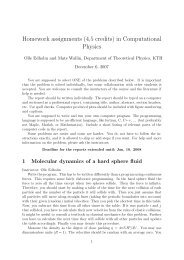
![[VAR]=Notes on variational calculus](https://img.yumpu.com/35639168/1/190x245/varnotes-on-variational-calculus.jpg?quality=85)